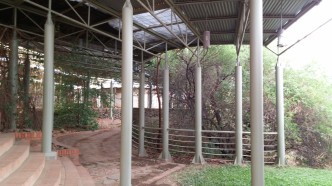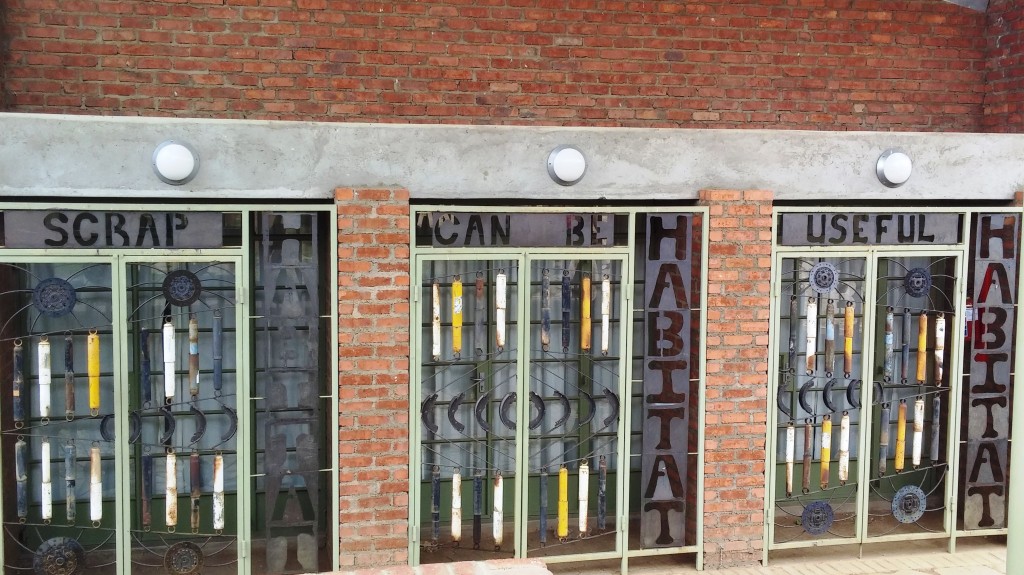Another catch-up day! Had trouble the other day connecting to wi-fi enough to post things- hoping that is due to the group watching a Seahawks game and not due to my laptop being old.
On Wednesday the 7th, our first full day here, we met with Jan and Martha, the head of the history department (along with a few other departments!) who will be leading our history/orientation course, to talk about what we will be doing and learning about this month. We’ve taken over the upstairs “wi-fi room” next door and have been using it as a sort of classroom/meeting room. Martha briefly outlined Namibia’s history which we will discuss in more detail over the next few weeks. Then on Thursday we had our first full four hours of class which, while on the long side with the heat, was very interesting for me especially because I haven’t taken a history course in such a long time and have never learned much about recent history in Africa. The race relations and mentality of Namibians is very diverse as different populations/locations have been differently affected by the various conflicts in recent history. So much change has occurred in just the past 50 years… it’s difficult to take everything in. I’ll do my best to summarize from the notes I’ve taken so far, but this may take a while.
While there were people living in the area now known as Namibia before colonization, this history has been recorded in ways that are more difficult to interpret today and our first discussion began with the European scramble for Africa in 1884. Germany had only recently become an organized nation (1871) and thus had less manpower for colonization than other countries and ended up with areas now known as Namibia, Tanzania, Cameroon, and Togo (although Germans only built settlements in Namibia because of its more favorable climate (and rumors of diamonds). German colonization in Namibia was made easier by the presence of German missionaries since the 1840s although resistance by local groups was common, in part due to differing ideas of ownership. After the First World War, Germany lost its colonies to the British and the French. Since Britain already had a presence in South Africa, Namibia (then known as South West Africa or Suid Wes Afrika in Afrikaans) became a mandate territory of the British.
During the period of colonial transition, little changed in Namibia until the 1920 native reserve policy separated people living in Namibia based on race and tribe. 1922 marked the first time in Africa that a community resistance effort was stopped with bombs from airplanes. However, between 1922 and 1930 there was still little South African activity in Namibia overall and while South African infrastructure developed, little similar development occurred in Namibia. Then in the 1930s, the Depression hit and 1940 marked the beginning of Apartheid in South Africa (and Namibia by extension). The systematic separation of people socially, economically, and geographically applied not only to divide whites and blacks, but also to divide blacks by 12 official tribes such that each person had paperwork indicating which group they belonged to and where they were allowed to live.
The 1950s marked stages of early nationalism for Namibians, especially for men from the northern part of the country who worked as part of the migrant labor system enforced during Apartheid. Although this system was problematic in many ways, it exposed Namibians (predominantly men) to South African liberation politics and in 1959 the first Namibian liberation movement, South West Africa National Union (SWANU), was established. This movement was shortly followed by the formation of SWAPO, the SW Africa People’s Organization which achieved international recognition both from the African Union, AU (Organization of African Unity at the time) and from United Nations. Thus, the 1960s marked the beginning of a national struggle for liberty as opposed to individual, local struggles and conflicts previously. In 1971, the International Court of Justice (ICJ, a branch of the UN) voted that South Africa could incorporate Namibia as a 5th province. However, after years of brutal conflict, UN resolution 435 was passed in 1978 in support of Namibian independence, calling for a cease fire, evacuation of South African troops, and a democratic election. Despite this resolution, progress was stalled, in part due to international tensions during the Cold War, and it was not until 1988 that UN officials entered to oversee the country’s first democratic election. Independence was declared on March 21, 1990, making this year the nation’s 25th anniversary.
(I know these pictures don’t match my text… bear with me) Post-independence, the redistribution and use of land or “land management,” has been one of the larger problems the country is still working to solve. During colonial periods in most African countries, the best land was generally reserved for whites and local people were moved, often by force, to less-desirable land. To account for this, different countries have taken different approaches. In Zambia, many whites were forced to give up their land to have it more equally distributed. Namibia on the other hand follows a policy of “willing buyer, willing seller” where the government offers a price for land and the person who owns it can choose to sell or not. Interestingly, today Namibia is the 2nd most expensive place to purchase land (following Dubai, India). However, much of the land in Namibia is not privately owned but owned by the state. “Communal land” is land that the government owns but is managed by an individual. This was very difficult for us to understand since it’s so different from the way land works in the United States. Also of interest are unwritten policies of reconciliation that differ between countries. After its independence, South Africa followed a policy of restorative justice (Desmond Tutu was involved with this process) where whites and blacks were encouraged to confess wrongdoings as a way to address what had happened and work past conflicts. In contrast, Namibia followed a policy of “blanket amnesty” which encouraged individuals to forgive and forget so to say.
What we heard from Martha was supplemented by a tour of Windhoek and various townships within it with Scobe and Martha on Friday. It was helpful to hear some of the history for a second time but with a different perspective on some points. We started at the National Museum of Namibia in downtown Windhoek. The building is a former concentration camp from the early 1900s that now serves as a museum. We didn’t go inside the building but saw the Monument commemorating the individuals killed during the genocide that occurred during German colonization (pictured above) and the statue within the compound of a German on horseback that was, pre-independence, a monument to German successes during the colonial period.
From there, we drove through one of the more “posh” neighborhoods in Windhoek, Ludwigsdorf. The homes here were mostly stone (no earthquakes here) and, well, posh. Wealthier people live in these homes, but not necessarily white people. Today there are black business owners and government officials that live there as well.
Next, we made our way through town and stopped at the 1959 Heroes and Heroines Memorial Grave where individuals who lived in the surrounding neighborhood (“The Old Location”) but were forced to relocate during Apartheid are buried. A large grave near the entrance bares the inscription:
“The Old Location Mass grave is a symbol of heroism and gallantry. The epitaph was erected in memory of the brave residents of the Old Location who were killed on 10 December 1959 by the brutal South African apartheid forces, for refusing to be relocated to the racially segregated township of Katutura. The Old Location uprising of 1959 is a rallying cry for Namibian independence never to be forgotten.”
After pausing at the graveyard, we continued to Katutura, the township of Windhoek where people were forced to relocate during apartheid. Today, December 10th is a national holiday, Human Rights Day, in memory of those who died resisting apartheid forces. The word Katutura translates to “we have no permanent habitation” and roughly 7,000 individuals were relocated there between 1959 and 1962. Today, no one is forced to live in Katutura and it is not strictly segregated and monitored as it once was. People of varying income levels live there and some of our nursing students will be working in the Katutura Hospital starting in February.

Many homes in Katutura have been refurbished since apartheid, bright colors and gardens are much more common today.
Our next stop, one of Scobe’s favorite places in Windhoek (and one of mine as well, so far), was the Habitat Research and Development Centre which, as I understand it, works to develop more efficient and resource conscious forms of low-cost housing with the goal of “promoting sustainable human settlements.” These would, ideally, provide alternatives to corrugated metal which is used for informal settlements today which are hot when it’s hot and cold when it’s cold. Many of the housing methods developed and on display there are not widely used due to high initial costs, but it is hopeful that this type of research is happening. Scrap materials were converted in to artwork, doorways, and buildings. Rainwater flows down corrugated metal roofs and is stored in columns. They also proudly display a solar cooking stove where sunlight reflects off a huge, shiny metal bowl which can adjust temperature based on the angle the bowl stands with respect to incoming rays (on sale for $700 Namibian dollars, a bit under $70 US).
After leaving the research centre, we continued to an informal settlement, the low-income housing in Namibia. Today there are efforts to formalize the settlements with street names and numbers, but the corrugated metal buildings access water from particular points (not running to each home), and have little or no electricity. However, we were struck by the cleanliness of the people we saw going about their lives in clothing that would in no way identify them (at least to us), as being from an informal settlement. Scobe reminded us that poverty doesn’t necessarily mean that people are unhappy or dissatisfied with your living conditions, “you don’t know you’re poor until someone tells you.” However, with increased technology and spreading of information, more people are becoming interested in changing their living conditions.
Our last stop before returning to campus was Penduka craft shop in Katatura. Penduka (“wake up!” in Oshiwambo) is an organization that started in 1992 to provide employment for women in and around Windhoek, including women who are hearing and speaking impaired. There are women employed at the craft shop to embroider, create batik, and make beads from glass bottle shards, but women from farther away can send crafts to the store to sell as well. We didn’t buy anything this time, but will definitely be back.
Overall, the tour gave us a better sense of the size and diversity/disparity within Windhoek, which , by area, is the 5th largest city in the world. The first few days have been busy, but we’ve mainly stuck to the Emona hostels so it was great to get out and see more of the city in addition to having a sense of context for talking with people here about different parts of town. All our meals so far (apart from pizza our first night) have been in the hostels and cooked by the girls in our group- so nothing too exotic yet! Salad, stir fry, chicken, and even peanut butter and jelly, have been common. Namibians tend to eat a lot of meat which will be an adjustment for me since I rarely eat meat at home, but we’ve been doing a lot of cooking for ourselves so far. Hope you are all doing well wherever you are reading from!
























GooD for you! You started your blog – we look forward to following you on your adventure in Africa!
LikeLike
Thanks! I’ll do my best to keep up with posting.
LikeLike